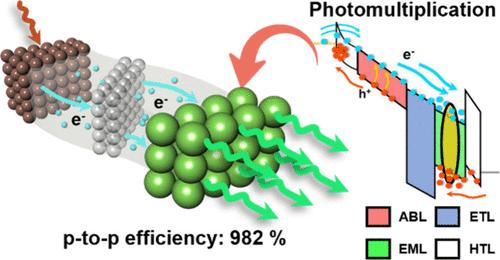当前位置:
X-MOL 学术
›
ACS Energy Lett.
›
论文详情
Our official English website, www.x-mol.net, welcomes your
feedback! (Note: you will need to create a separate account there.)
Designing a Quantum Dot Upconversion Infrared Image Sensor via a Photomultiplication Mechanism
ACS Energy Letters ( IF 19.3 ) Pub Date : 2024-11-19 , DOI: 10.1021/acsenergylett.4c02088 Seongkeun Oh, Suk-Young Yoon, Byung Ku Jung, Young Kyun Choi, Junhyuk Ahn, Junhyeok Park, Hanseok Seo, Tse Nga Ng, Heesun Yang, Soong Ju Oh
ACS Energy Letters ( IF 19.3 ) Pub Date : 2024-11-19 , DOI: 10.1021/acsenergylett.4c02088 Seongkeun Oh, Suk-Young Yoon, Byung Ku Jung, Young Kyun Choi, Junhyuk Ahn, Junhyeok Park, Hanseok Seo, Tse Nga Ng, Heesun Yang, Soong Ju Oh

|
The upconversion infrared (IR) image sensor selectively emits visible light photons from the regions that have absorbed IR photons, allowing for simplified manufacturing without the need for complex pixel integration. These pixel-less upconversion IR image sensors enable low-cost, nondestructive imaging in the Internet of Things, security, and bioimaging applications, which include identifying blood circulation, tumors, and vascular structures. Here we designed the material and structure of a quantum dot upconversion IR image sensor (QUIS) and achieved a photon-to-photon efficiency of 982% by inducing photomultiplication. A QUIS, designed with an inverted structure for charge balance, uses Mg-alloyed ZnO nanoparticles as an electron transport layer to control the electron–hole ratio. We analyzed the type and amount of charge present within the QUIS, elucidating the mechanism driving photomultiplication and the origin of photon-to-electron efficiency exceeding 100000%. The pixel-free QUIS is demonstrated as a bioimaging sensor by detecting human movement and blood pulse detection.
中文翻译:

通过光倍增机制设计量子点上转换红外图像传感器
上转换红外 (IR) 图像传感器选择性地从吸收 IR 光子的区域发射可见光光子,无需复杂的像素集成即可简化制造。这些无像素上转换红外图像传感器可在物联网、安全和生物成像应用中实现低成本、无损成像,包括识别血液循环、肿瘤和血管结构。在这里,我们设计了量子点上转换红外图像传感器 (QUIS) 的材料和结构,并通过诱导光倍增实现了 982% 的光子到光子效率。QUIS 设计为具有电荷平衡的倒置结构,使用 Mg 合金化的 ZnO 纳米颗粒作为电子传输层来控制电子-空穴比。我们分析了 QUIS 中存在的电荷类型和数量,阐明了驱动光倍增的机制和光子-电子效率超过 100000% 的起源。无像素 QUIS 通过检测人体运动和血脉检测来演示为生物成像传感器。
更新日期:2024-11-20
中文翻译:

通过光倍增机制设计量子点上转换红外图像传感器
上转换红外 (IR) 图像传感器选择性地从吸收 IR 光子的区域发射可见光光子,无需复杂的像素集成即可简化制造。这些无像素上转换红外图像传感器可在物联网、安全和生物成像应用中实现低成本、无损成像,包括识别血液循环、肿瘤和血管结构。在这里,我们设计了量子点上转换红外图像传感器 (QUIS) 的材料和结构,并通过诱导光倍增实现了 982% 的光子到光子效率。QUIS 设计为具有电荷平衡的倒置结构,使用 Mg 合金化的 ZnO 纳米颗粒作为电子传输层来控制电子-空穴比。我们分析了 QUIS 中存在的电荷类型和数量,阐明了驱动光倍增的机制和光子-电子效率超过 100000% 的起源。无像素 QUIS 通过检测人体运动和血脉检测来演示为生物成像传感器。


















































 京公网安备 11010802027423号
京公网安备 11010802027423号